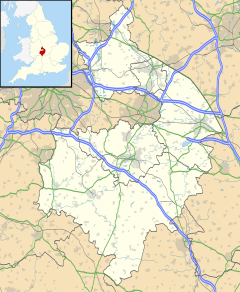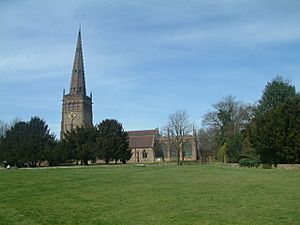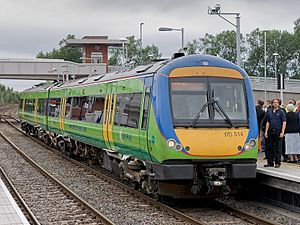Coleshill, Warwickshire facts for kids
Quick facts for kids Coleshill |
|
|---|---|
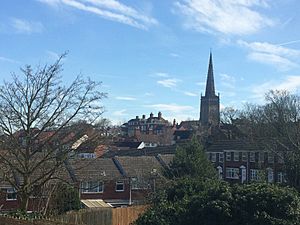 Seen from the northwest with the Church of St. Peter and St. Paul in view |
|
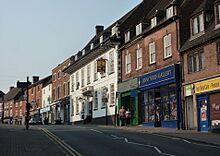 High Street |
|
| Population | 6,900 (2021 Census) |
| OS grid reference | SP2089 |
| Civil parish |
|
| District |
|
| Shire county | |
| Region | |
| Country | England |
| Sovereign state | United Kingdom |
| Post town | BIRMINGHAM |
| Postcode district | B46 |
| Dialling code | 01675 |
| Police | Warwickshire |
| Fire | Warwickshire |
| Ambulance | West Midlands |
| EU Parliament | West Midlands |
| UK Parliament |
|
Coleshill (pronounced KOH-zil) is a historic market town located in Warwickshire, England. It gets its name from the River Cole, which flows nearby. In 2021, about 6,900 people lived here. Coleshill is about 11 miles (18 km) east of Birmingham. It is also home to The Coleshill School, which is over 500 years old!
Contents
Where is Coleshill Located?
Coleshill sits on a raised area of land between two rivers, the River Cole and the River Blythe. These rivers join the River Tame to the north. The town is very close to the border of the West Midlands county, just outside Birmingham.
What is the Weather Like in Coleshill?
Coleshill has a mild climate, typical for England. Summers are usually warm, with average high temperatures around 22°C (72°F) in July. Winters are cool, with average high temperatures around 7°C (45°F) in January. The town receives a moderate amount of rain throughout the year, with October often being the wettest month. There's also a good amount of sunshine, especially from May to July.
| Climate data for Coleshill (1991–2020) | |||||||||||||
|---|---|---|---|---|---|---|---|---|---|---|---|---|---|
| Month | Jan | Feb | Mar | Apr | May | Jun | Jul | Aug | Sep | Oct | Nov | Dec | Year |
| Mean daily maximum °C (°F) | 7.3 (45.1) |
8.0 (46.4) |
10.5 (50.9) |
13.5 (56.3) |
16.6 (61.9) |
19.6 (67.3) |
22.0 (71.6) |
21.5 (70.7) |
18.6 (65.5) |
14.2 (57.6) |
10.2 (50.4) |
7.6 (45.7) |
14.2 (57.6) |
| Mean daily minimum °C (°F) | 1.7 (35.1) |
1.7 (35.1) |
2.9 (37.2) |
4.4 (39.9) |
7.1 (44.8) |
10.0 (50.0) |
12.0 (53.6) |
12.0 (53.6) |
10.0 (50.0) |
7.3 (45.1) |
4.2 (39.6) |
2.0 (35.6) |
6.3 (43.3) |
| Average rainfall mm (inches) | 63.6 (2.50) |
47.0 (1.85) |
46.6 (1.83) |
48.1 (1.89) |
53.8 (2.12) |
64.9 (2.56) |
52.9 (2.08) |
66.2 (2.61) |
58.1 (2.29) |
72.8 (2.87) |
69.6 (2.74) |
64.7 (2.55) |
708.2 (27.88) |
| Average rainy days (≥ 1 mm) | 12.4 | 9.8 | 9.9 | 10.1 | 9.8 | 9.6 | 8.9 | 10.5 | 9.6 | 11.6 | 13.0 | 11.7 | 127.1 |
| Mean monthly sunshine hours | 55.1 | 72.0 | 116.7 | 147.1 | 193.3 | 192.6 | 194.0 | 170.7 | 130.7 | 100.2 | 66.2 | 62.6 | 1,501.2 |
| Source: Met Office | |||||||||||||
A Look at Coleshill's Past
Coleshill has a very long history, going back to the Iron Age, even before the Romans arrived in 43 AD. Archaeologists found evidence of ancient hut circles and a Roman-Celtic temple on Grimstock Hill. This shows that people lived and worshipped here for a very long time.
After the Roman period, during the Dark Ages, the main part of Coleshill moved to the top of the hill where the current church stands. This is where the medieval town grew.
By 1066, Coleshill was a royal manor owned by King Edward the Confessor. It was even mentioned in the Domesday Book of 1086, which was a big survey of England ordered by William the Conqueror.
In 1207, King John gave Coleshill the right to hold a market. This was a big deal, as it helped the town grow and become a center for trade. Later, when stagecoaches were common, Coleshill became an important stop on the roads from London to places like Chester and Holyhead. At one time, there were more than twenty inns in the town to host travelers!
Cool Buildings in Coleshill
Many old coaching inns, which were like hotels for stagecoaches, can still be seen along the High Street and Coventry Road. One of the most famous buildings is the Church of St Peter and St Paul. It has a tall steeple, about 52 meters (170 feet) high, which was built in the 13th century. Inside, you can see a very old font from the 12th century and tombs with statues of knights.
On Church Street, you can find the town's old pillory and whipping post. These were used for punishments a long time ago, with the last time being in 1863. In the High Street, there's a bronze sculpture that tells the story of the town. It shows a stagecoach wheel, a circus elephant, and even a nod to the creation of the Typhoo Tea brand!
Getting Around Coleshill
Coleshill is easy to reach by road because it's close to major motorways like the M6, M6 Toll, and M42 motorway. It's right near Junction 4 of the M6.
You can also travel by bus. Two regular bus routes serve the town: the X13 connects Coleshill to Birmingham and Chelmsley Wood, and the 76 goes between Tamworth and Sutton Coldfield.
The town has its own train station, Coleshill Parkway railway station, which reopened in 2007. It's on the line that connects Birmingham to Peterborough. Trains run every half hour, making it easy to travel to places like Nuneaton, Leicester, and even Stansted Airport.
Coleshill in the Media
Local news and TV shows for Coleshill come from BBC West Midlands and ITV Central. You can also listen to several radio stations, including BBC WM and Heart West Midlands. The town is served by local newspapers like the Leamington Courier and Warwick Courier.
Coleshill's Twin Town
Since 1983, Coleshill has been twinned with Chassieu, a town near Lyons in France. This means the two towns have a special friendship and often exchange visits.
Schools in Coleshill
Coleshill has several schools for young people:
- The Coleshill School
- Coleshill Church of England Primary School
- St Edwards Roman Catholic Primary School
- High Meadow Community School Primary School
- Woodland Special School
Famous People from Coleshill
Some notable people have connections to Coleshill:
- Reverend George Lloyd (1820–1885), who was a church leader and also an archaeologist.
- Baron Plumb, a farmer and politician who passed away in 2023.
- John Wynne (1819–1893), a well-known cricketer.
See also
 In Spanish: Coleshill (Warwickshire) para niños
In Spanish: Coleshill (Warwickshire) para niños


